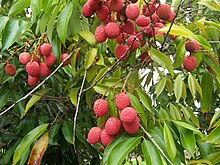Lychee
Lychee (US: /ˈliːˌtʃiː/ LEE-chee; UK: /ˈlaɪˌtʃiː/ LIE-chee; Litchi chinensis; Chinese: 荔枝; pinyin: lìzhī; Jyutping: lai6 zi1; Pe̍h-ōe-jī: nāi-chi) is a monotypic taxon and the sole member in the genus Litchi in the soapberry family, Sapindaceae.
| Lychee | |
|---|---|

| |
| Scientific classification | |
| Kingdom: | Plantae |
| Clade: | Tracheophytes |
| Clade: | Angiosperms |
| Clade: | Eudicots |
| Clade: | Rosids |
| Order: | Sapindales |
| Family: | Sapindaceae |
| Subfamily: | Sapindoideae |
| Genus: | Litchi Sonn. |
| Species: | L. chinensis
|
| Binomial name | |
| Litchi chinensis | |
| Synonyms | |
| |
| Lychee | |||||||||||||||||||||||||||
|---|---|---|---|---|---|---|---|---|---|---|---|---|---|---|---|---|---|---|---|---|---|---|---|---|---|---|---|
| Chinese | 荔枝 | ||||||||||||||||||||||||||
| |||||||||||||||||||||||||||
It is a tropical tree native to South China, Malaysia, and northern Vietnam. The tree has been introduced throughout Southeast Asia and South Asia. Cultivation in China is documented from the 11th century. China is the main producer of lychees, followed by Vietnam, India, other countries in Southeast Asia, other countries in the Indian subcontinent, Madagascar, and South Africa. A tall evergreen tree, it bears small fleshy sweet fruits. The outside of the fruit is a pink-red, rough-textured soft shell.
Lychee seeds contain methylene cyclopropyl glycine which has caused hypoglycemia associated with outbreaks of encephalopathy in undernourished Indian and Vietnamese children who consumed lychee fruit.
